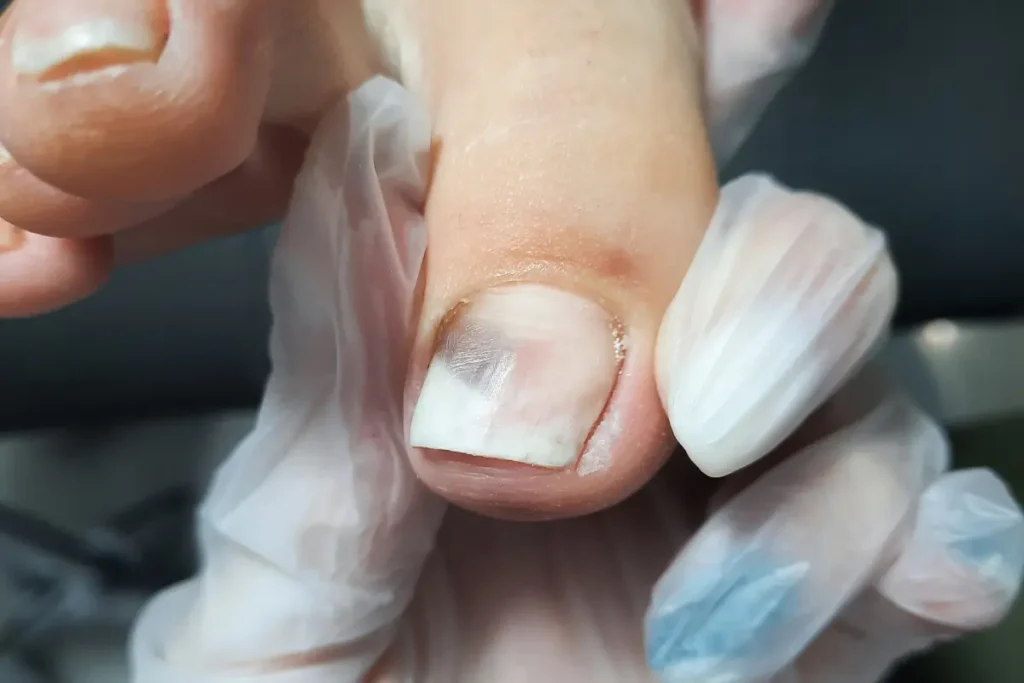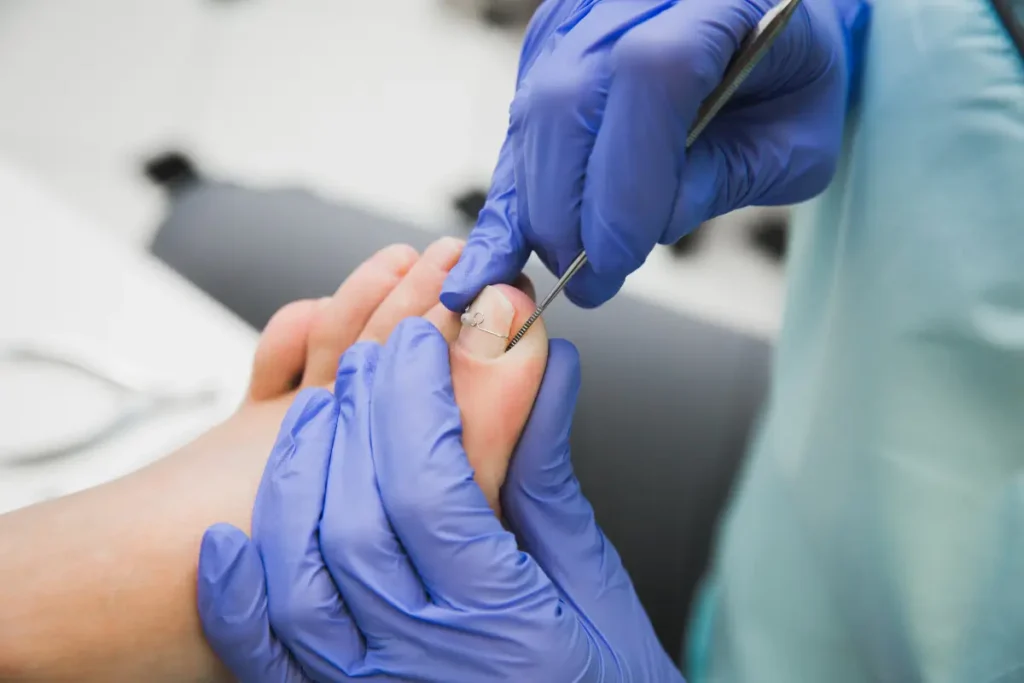This guide is for informational purposes only. Some services may not be offered in our offices. Your doctor will guide you through your treatment options during your appointment.
Noticing a black spot on your toenail can be alarming. While it might be tempting to dismiss it as a simple bruise, there are several potential causes—some more serious than others. From minor injuries to fungal infections, and even signs of more severe conditions like melanoma, understanding the reason behind this discoloration is crucial for your health.
In this guide, we’ll explore the most common causes of black spots on toenails, when to treat them at home, and when to seek medical attention. We’ll also discuss prevention tips and treatments to keep your toenails healthy and problem-free.
What Causes Black Spots?
A black spot on your toenail may arise from various underlying issues, ranging from benign to serious. Common causes include:
• Trauma: Injuries like stubbing your toe or chronic pressure from ill-fitting shoes can damage small blood vessels, resulting in black or reddish-brown marks.
• Fungal Infections: Conditions such as Tinea Nigra, caused by the fungus Hortaea werneckii, can manifest as dark patches on the toenail.
• Subungual Melanoma: This rare form of skin cancer presents as dark streaks or spots under the nail and requires prompt medical evaluation.
The Role of Nail Health
Nails, composed of keratin layers, serve as indicators of overall health. Disruptions in nail growth due to injury, infections, or underlying health conditions can alter nail appearance. Regularly monitoring nail changes can help in early detection of potential health issues.
Recognizing Symptoms
Identifying the characteristics of black spots is crucial for appropriate management. Look for signs like:
• Size and Shape: A small, round black spot may indicate a bruise, while an elongated streak could be more serious.
• Accompanying Symptoms: Swelling, pain, or changes in nail texture can signal a need for medical assessment.
Trauma and Discoloration
Trauma-induced black spots are more common than you might think. These occur when small blood vessels beneath the nail bed rupture due to:
• Dropping heavy objects on your toe.
• Repeated pressure from poorly fitting shoes.
This type of injury often leads to subungual hematoma, which manifests as:
• A red or purple mark under the nail.
• Pain or throbbing in the affected area.
If blood accumulates and causes significant discomfort, medical intervention may be necessary to drain the hematoma.
Fungal Infections
Fungal infections are another leading cause of black spots on toenails. Tinea Nigra is particularly prevalent in individuals with:
• Frequent exposure to damp environments.
• Poor foot hygiene.
This infection can be diagnosed through mycological examinations. Treatment options include:
• Topical Antifungal Treatments: Applied for 2 to 4 weeks to eliminate the infection.
• Home Remedies: Tea tree oil and diluted apple cider vinegar are popular among those seeking natural solutions.
Potential Health Issues
Changes in toenail appearance can sometimes indicate underlying systemic conditions, such as:
• Diabetes
• Kidney Disease
• Autoimmune Disorders
These conditions can affect nail health, leading to changes in color or texture. For instance, pale or white nails may signal anemia, while pitting or ridging could indicate psoriasis or other systemic diseases.
Heavy Metal Poisoning
While it may sound alarming, heavy metal poisoning can also affect toenail appearance. Symptoms may include:
• Beau’s lines, which are horizontal lines across the nail.
• Changes in nail color, such as white spots.
If you suspect heavy metal exposure, consult a healthcare provider for proper testing and treatment.
Recognizing Subungual Melanoma
Subungual melanoma is a serious concern that presents as brown or black streaks beneath the nail. Key features include:
• Dark streaks that resemble bruises.
• Potentially spreading pigmentation to surrounding skin.
If you notice persistent dark streaks, particularly with symptoms like nail brittleness or bleeding, seek medical attention promptly.

Seeking Medical Advice
When dealing with a black spot on your toenail, proper identification of its cause is essential. Consult a healthcare professional if:
• The black spot changes shape or size.
• It is accompanied by pain, swelling, or discharge.
Early intervention can prevent the progression of conditions like subungual melanoma and reduce the risk of complications.
Home Care for Minor Issues
For minor injuries or fungal infections, consider the following self-care strategies:
• Maintain Good Foot Hygiene: Keep your feet clean and dry to minimize infection risk.
• Use Antifungal Treatments: Over-the-counter options may help with mild fungal infections.
• Avoid Tight Footwear: Choose well-fitting shoes to prevent trauma and discomfort.
Regular Nail Care
Maintaining nail health is crucial for prevention. Consider these practices:
• Trim toenails regularly and properly to avoid injuries.
• Be cautious with nail products, avoiding dyes and chemicals that could cause staining.
• Wear protective footwear in communal areas to minimize exposure to fungal infections.
Consulting a Specialist
If black toenails persist despite home treatment, consider visiting a foot and ankle specialist (podiatrist). Persistent issues, especially alongside conditions like diabetes, warrant professional evaluation. A podiatrist can provide accurate diagnosis and tailored treatment options, from antifungal medications to surgical interventions for severe cases.

The information on our website is intended for general informational and educational purposes only and should not be used as a substitute for professional medical advice. For any health-related concerns, we strongly recommend consulting with a healthcare professional. Please note that any reliance on the information found on our site is solely at your own risk. For more details, please see our Medical Disclaimer.
Modern Foot & Ankle offers expert foot and ankle care, conveniently located in your Florida or Texas community. Our multiple locations offer a wide network of the best podiatrists, skillfully trained to meet your specific needs. Our nationally recognized physicians and surgeons cover the full spectrum of foot and ankle concerns, including complex lower extremity conditions. Our foot and ankle doctors combine advanced technology with patient-centric care to deliver treatment plans to get you back on your feet, often right inside your neighborhood.
Browse our extensive network of offices across Florida and Texas, and experience the best foot and ankle care at your nearest local Modern Foot & Ankle location.
Stay informed by reviewing some of our patients frequently asked questions about what to expect when visiting one of our Florida or Texas foot and ankle care offices. Contact the office directly if you need further assistance. We’re here to help!
Modern Foot & Ankle offers a wide range of podiatry services including foot and ankle surgery, sports medicine, pediatric foot care, wound care, orthotics, and more. They also provide specialized treatments for conditions such as bunions, hammertoes, heel pain, and ingrown toenails among others.
To schedule an appointment, you can call the clinic directly or fill out the appointment request form available on their website. They have multiple locations, so you can choose the one that’s most convenient for you.
During your first visit, the podiatrist will conduct a thorough examination, discuss your medical history, and address any concerns or symptoms you may have. They will then develop a personalized treatment plan based on your specific needs.
Yes, the podiatrists at Modern Foot & Ankle are skilled in performing a variety of foot and ankle surgeries. These include procedures for bunions, hammertoes, fractures, and more. They utilize the latest techniques and technology to ensure the best possible outcomes for their patients.
Modern Foot & Ankle is committed to providing comprehensive, high-quality podiatric care. They believe in a patient-centered approach, where the focus is on educating patients about their condition and treatment options, enabling them to make informed decisions about their care.
Modern Foot & Ankle accepts a variety of insurance plans. It’s recommended to check with the clinic directly or with your insurance provider to confirm coverage before scheduling an appointment.

